How to protect yourself and others from COVID-19
COVID-19 - Prevention; 2019 Novel Coronavirus - Prevention; SARS CoV 2 - Prevention
Coronavirus disease 2019 (COVID-19) is a serious disease, mainly of the respiratory system, affecting many people around the globe. It can cause mild to severe illness and even death. COVID-19 spreads easily between people. Learn how to protect yourself and others from this illness.
Images
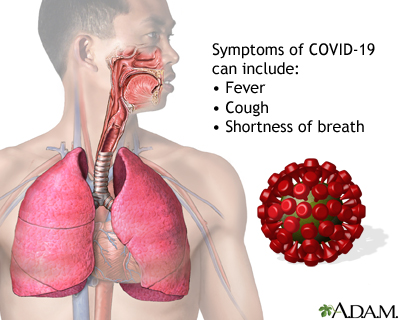
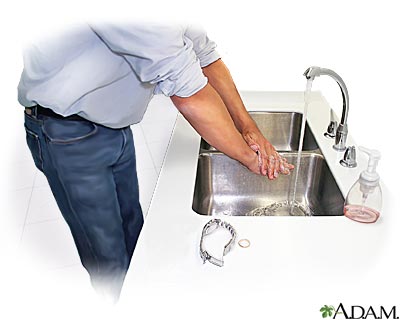
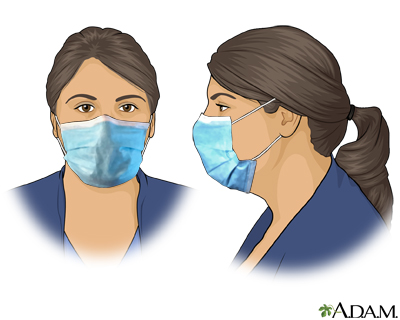
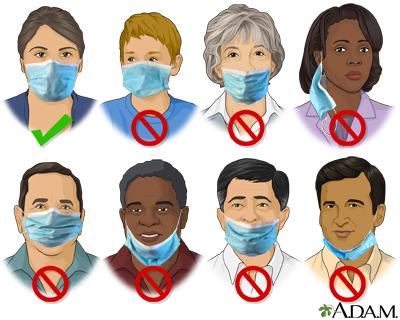
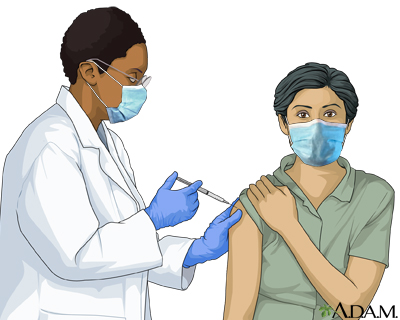
I Would Like to Learn About:
Information
HOW COVID-19 SPREADS
COVID-19 is an illness caused by infection with the SARS-CoV-2 virus. COVID-19 most commonly spreads between people with close contact (about 6 feet or 2 meters). When someone with the illness coughs, sneezes, sings, talks, or breathes, droplets carrying the virus spray into the air. You can catch the illness if you breathe in these droplets or they get in your eyes.
In some instances, COVID-19 may spread through the air and infect people who are more than 6 feet away. Small droplets and particles can remain in the air for minutes to hours. This is called airborne (or aerosol) transmission, and it occurs mainly in enclosed spaces with poor ventilation. However, it is more common for COVID-19 to spread through close contact.
Less often, the illness can spread if you touch a surface with the virus on it, and then touch your eyes, nose, mouth, or face. But this is a much less common way the virus spreads.
HOW TO PREVENT COVID-19
You can spread COVID-19 before you show symptoms. Some people with the illness never have symptoms, but can still spread the disease. However, there are ways to protect yourself and others from getting COVID-19. These tips can help you and others stay safe:
- Get an updated COVID-19 vaccine. Being vaccinated helps protect you from getting and spreading COVID-19. Being vaccinated can also help protect you from serious illness if you do get the virus.
- Make sure children ages 6 months and older get the COVID-19 vaccine. Getting children and teens vaccinated helps prevent them from spreading COVID-19 to older relatives and young siblings and friends who can't or don't get the vaccine. It also helps protect children and teens from serious illness.
- If you are vaccinated, and in an area where COVID-19 hospital admission rates are high, you can wear a face mask or respirator that fits well without gaps when you are indoors in public.
- If you have a weakened immune system, you may want to wear a face mask indoors in public regardless of how active COVID-19 is in your community.
- Avoid poorly ventilated indoor spaces and crowded areas, even if you are vaccinated. If you are indoors, open windows and doors and use fans to help bring in outdoor air, when possible. Use a portable high-efficiency particulate air (HEPA) cleaner. Spending time outdoors or in well-ventilated spaces can help reduce your exposure to respiratory droplets.
- COVID-19 tests can help prevent the spread to others. You can use COVID-19 self-tests at home and get quick results whether or not you have symptoms.
- Wash your hands many times a day with soap and running water for at least 20 seconds. In general, this is a good practice to help prevent the spread of germs. Do this before eating or preparing food, after using the toilet, and after coughing, sneezing, or blowing your nose. Use an alcohol-based hand sanitizer (at least 60% alcohol) if soap and water are not available.
- Cover your mouth and nose with a tissue or your sleeve (not your hands) when coughing or sneezing. Droplets that are released when a person sneezes or coughs are infectious. Throw away the tissue after use.
- Avoid touching your face, eyes, nose, and mouth with unwashed hands.
- Do not share personal items such as cups, eating utensils, towels, or bedding. Wash anything you have used in soap and water.
- Know the symptoms of COVID-19. If you develop any symptoms, contact your health care provider.
- Stay home if you think you have COVID-19 or test positive for the virus. Follow guidance for how long to stay away from others and when you can safely resume normal activities, as listed below.
WHAT TO DO IF YOU GET COVID-19
If you have COVID-19 or have symptoms of it, you must stay at home and avoid contact with other people, both inside and outside your home, to avoid spreading the illness.
Once you start to feel better, you can go back to your normal activities if both of the following things are true:
- For at least 24 hours, your symptoms have improved and
- You have not had a fever for at least 24 hours, and you are not using fever-reducing medicine
Even though you feel better, you may still be able to spread the virus to others for several days. For this reason, once you go back to your normal activities, continue to protect others from illness by taking these steps for 5 days:
- Practice good hygiene by washing your hands and cleaning "high touch" areas around your home.
- Take steps to bring cleaner air inside your home by opening windows and using exhaust fans.
- Wear a mask around others.
- Practice physical distancing by avoiding close contact and avoiding crowds.
- Self-test for COVID-19 before being indoors with others.
You should also practice these steps for 5 days if you tested positive for COVID-19, but did not have any symptoms. Even though you have no symptoms, you can still spread the virus to others. Doing so will protect people at risk for serious illness, such as people who are immunocompromised.
If your fever returns after resuming normal activities, you should go back to staying home and away from others. Once your fever and symptoms improve for more than 24 hours, you can resume activities while taking steps to protect others for 5 more days.
References
Centers for Disease Control and Prevention website. COVID-19: About COVID-19. www.cdc.gov/covid/about/index.html. Updated June 13, 2024. Accessed December 24, 2024.
Centers for Disease Control and Prevention website. The National Institute For Occupational Safety and Health (NIOSH). Personal protective equipment. www.cdc.gov/niosh/ppe/. Accessed April 29, 2025.
Centers for Disease Control and Prevention website. COVID-19: How to protect yourself and others. www.cdc.gov/covid/prevention/index.html. Updated July 12, 2024. Accessed December 24, 2024.
Centers for Disease Control and Prevention website. COVID-19: Masks and respiratory virus prevention. www.cdc.gov/respiratory-viruses/prevention/masks.html. Updated March 1, 2024. Accessed December 24, 2024.
Centers for Disease Control and Prevention website. Respiratory virus guidance. www.cdc.gov/respiratory-viruses/guidance/. Updated March 1, 2024. Accessed December 21, 2024.
Centers for Disease Control and Prevention website. Staying up to date with COVID-19 vaccines. www.cdc.gov/covid/vaccines/stay-up-to-date.html. Updated October 3, 2024. Accessed December 21, 2024.
BACK TO TOPReview Date: 1/1/2025
Reviewed By: Linda J. Vorvick, MD, Clinical Professor Emeritus, Department of Family Medicine, UW Medicine, School of Medicine, University of Washington, Seattle, WA. Also reviewed by David C. Dugdale, MD, Medical Director, Brenda Conaway, Editorial Director, and the A.D.A.M. Editorial team.

Health Content Provider
06/01/2025
|
A.D.A.M., Inc. is accredited by URAC, for Health Content Provider (www.urac.org). URAC's accreditation program is an independent audit to verify that A.D.A.M. follows rigorous standards of quality and accountability. A.D.A.M. is among the first to achieve this important distinction for online health information and services. Learn more about A.D.A.M.'s editorial policy, editorial process and privacy policy. A.D.A.M. is also a founding member of Hi-Ethics. This site complied with the HONcode standard for trustworthy health information from 1995 to 2022, after which HON (Health On the Net, a not-for-profit organization that promoted transparent and reliable health information online) was discontinued. |
The information provided herein should not be used during any medical emergency or for the diagnosis or treatment of any medical condition. A licensed medical professional should be consulted for diagnosis and treatment of any and all medical conditions. Links to other sites are provided for information only -- they do not constitute endorsements of those other sites. © 1997- 2025 A.D.A.M., a business unit of Ebix, Inc. Any duplication or distribution of the information contained herein is strictly prohibited.
